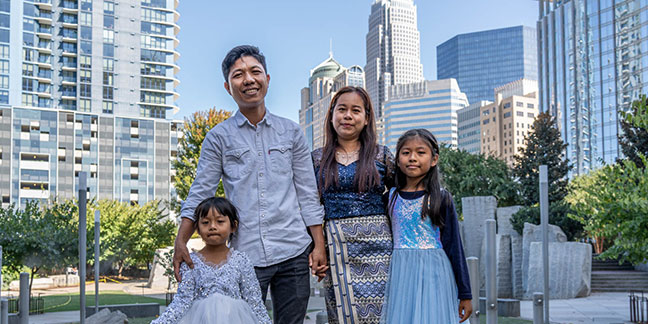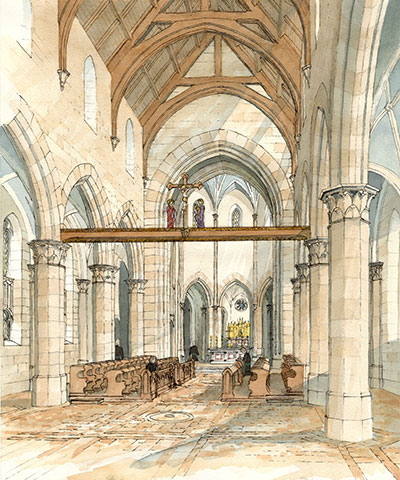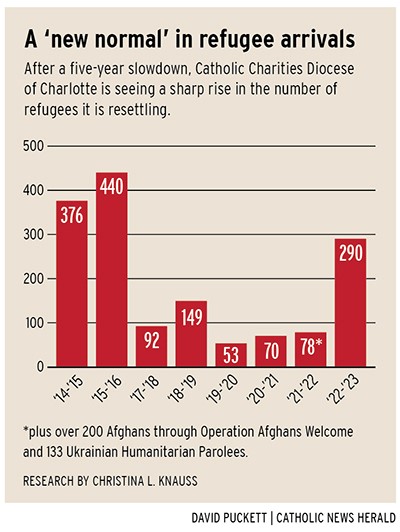Building new lives
 Nant Si and her husband and two young daughters are among those who now call Charlotte home, thanks to Catholic Charities and generous parishioners across the diocese who help fund the program. (Photo by Troy Hull)CHARLOTTE — After a five-year slowdown, Catholic Charities has seen a sharp increase in the number of refugees coming into the Diocese of Charlotte to build new lives after escaping conflicts around the world.
Nant Si and her husband and two young daughters are among those who now call Charlotte home, thanks to Catholic Charities and generous parishioners across the diocese who help fund the program. (Photo by Troy Hull)CHARLOTTE — After a five-year slowdown, Catholic Charities has seen a sharp increase in the number of refugees coming into the Diocese of Charlotte to build new lives after escaping conflicts around the world.
The agency resettled 290 refugees in fiscal year 2023, which ended Sept. 30, as families fled violence and persecution in countries including Congo, Myanmar and Syria.
That’s dramatically more than Catholic Charities has welcomed in the diocese since fiscal year 2017, when the agency resettled 306 refugees.
Program leaders expect to receive at least 375 refugees this fiscal year and say the higher numbers reflect a “new normal” for its Refugee Resettlement program. The figures do not include special U.S. evacuation efforts such as those from Afghanistan in 2021 and Ukraine in 2022 – which brought an additional 333 evacuees into the diocese.
Nant Si and her family are among those who now call Charlotte home, thanks to Catholic Charities and generous parishioners across the diocese who help fund the Refugee
Resettlement program.
“I love Charlotte because we now have freedom,” said Si, who arrived with her husband and two young daughters in December 2022. “We don’t have to deal with violence, with police asking us for bribes…and every week on Sundays we are free to go to church to worship God.”
Si and her husband separately fled violence in Myanmar years ago, after a new government began persecuting the country’s Christian minority. They met and married in refugee housing in Malaysia, where they waited years for a chance to get to the U.S. Now, they’re working, living and raising their 3- and 9-year-old girls in an east Charlotte apartment decorated with family photos and a wedding portrait taken at their Malaysian ceremony.
“It’s rewarding to know you’re helping people start a new life,” said Catholic Charities caseworker Conor McSweeney. “We’re also building communities within Charlotte where the refugees can find support and help from others from their home countries.”
Growing Refugee Numbers
 Two girls spend time at a local roller rink during Catholic Charities’ “Refugee Summer Camp.” (Provided by Catholic Charities)The number of refugees seeking new homes and lives in the Charlotte diocese has varied widely, depending on the approach of the U.S. government, which each year sets a total number of refugees the country will accept. That number can be compounded by special evacuations at moments of international crisis – as it was after the U.S. withdrawal from Afghanistan and the Russian war on Ukraine.
Two girls spend time at a local roller rink during Catholic Charities’ “Refugee Summer Camp.” (Provided by Catholic Charities)The number of refugees seeking new homes and lives in the Charlotte diocese has varied widely, depending on the approach of the U.S. government, which each year sets a total number of refugees the country will accept. That number can be compounded by special evacuations at moments of international crisis – as it was after the U.S. withdrawal from Afghanistan and the Russian war on Ukraine.
Catholic Charities offices around the country work in partnership with the U.S. Conference of Catholic Bishops and the U.S. State Department to resettle refugees fleeing war, political upheaval, or religious, economic or ethnic persecution.
“Situations around the world change and affect the number of people we assist each year,” said Laura Townsend Jones, Catholic Charities’ assistant regional director for refugee services. “Sadly, the number of displaced people around the world has reached 100 million, and only one half of one percent of them eventually get a chance to be resettled in another country.”
The highest number of refugee arrivals in the past decade came in FY 2015-16, when Catholic Charities welcomed 440 people into the diocese. But that number declined sharply beginning in 2017 – hitting historic lows between 2019 and 2021 – due to changes in federal immigration policies and the impact of the COVID-19 pandemic.
The number of refugees rebounded in the most recent fiscal year and based on estimates from federal officials, Jones expects a “new normal” of hundreds of refugees – unless federal policy changes again. Resettling families in a new land is complicated by language and cultural barriers, refugees’ lack of resources and, in communities like Charlotte, a severe shortage of affordable housing.
In addition to resettlement services, Catholic Charities continues to provide assistance in a variety of ways for another 300 to 400 refugees for up to five years, including continued case management, employment assistance and youth services.
Easing the Transition
 A young boy enjoys swimming at the “Refugee Summer Camp,” an annual event organized by Catholic Charities. (Photo provided by Catholic Charities)People who make it to the U.S. for resettlement go through a lengthy application process and often wait for years in crowded refugee camps in other countries. Catholic Charities is notified of impending newcomers about two weeks before they arrive. Finding affordable rental housing is the biggest challenge, Jones said, particularly in Charlotte and Asheville, where Catholic Charities has a second regional office and offers a full slate of resettlement services.. Language barriers and refugee families’ lack of a credit rating add to the struggle.
A young boy enjoys swimming at the “Refugee Summer Camp,” an annual event organized by Catholic Charities. (Photo provided by Catholic Charities)People who make it to the U.S. for resettlement go through a lengthy application process and often wait for years in crowded refugee camps in other countries. Catholic Charities is notified of impending newcomers about two weeks before they arrive. Finding affordable rental housing is the biggest challenge, Jones said, particularly in Charlotte and Asheville, where Catholic Charities has a second regional office and offers a full slate of resettlement services.. Language barriers and refugee families’ lack of a credit rating add to the struggle.
“We’ve built strong relationships with landlords around the area to try to find apartments, but in many cases we’re having to look further outside Charlotte to find them,” she said.
Many of the newest arrivals to the area, including Si and her family, are settled in apartment complexes in “ring communities” outside of Charlotte, Jones said.
Refugees often arrive with few possessions, so the new housing is furnished by a group called Homemakers of Mercy that works with Catholic Charities. Volunteers from several parishes around the Charlotte area – including St. Gabriel and St. Matthew – collect donations of new or gently used furniture and other items, then set up the apartments in advance so families will have a ready home.
Catholic Charities also offers employment services and youth programs for refugee families, as well as help enrolling in English classes and teaching families about life in North Carolina, including such skills as how to ride public transportation.
The goal is for new families to find work within 30 to 60 days of their arrival, and a swift transition to self-sufficiency. Si’s husband, Chung Thang, landed a job at a local Chinese restaurant and eventually was able to get a car after several months of struggling to find rides to work.
Si and her husband said they are grateful for the work of Catholic Charities, which has provided stability and hope. Si is working online toward her GED and dreams of going to college to study accounting. Her oldest daughter, Miracle, likes her elementary school classes and has made friends with children from other countries who live in their apartment complex.
“I am so thankful for the things we are able to do now, and I’m hoping God will give me a chance to go on with school,” she said. “I am so happy that Catholic Charities was able to help us come to Charlotte.”
— Christina Lee Knauss
 Want to help?
Want to help?
At www.ccdoc.org: Go online to donate, volunteer or learn more about Catholic Charities Diocese of Charlotte’s resettlement program, or call 704-370-3251.
Building up the faithful
 MOUNT HOLLY — St. Joseph College Seminary is every bit as idyllic as portrayed in its popular videos – a friendly rector of firm purpose forming cassock-donning young men to have “hearts full of charity” as they discern the priesthood, joyful Daughters of the Virgin Mother clad in long flowing habits working with the seminarians and priests, echoes of beautiful Latin chants, striking Gothic architecture, forested land beyond wide-open spaces, and two gentle, larger-than-life canines.
MOUNT HOLLY — St. Joseph College Seminary is every bit as idyllic as portrayed in its popular videos – a friendly rector of firm purpose forming cassock-donning young men to have “hearts full of charity” as they discern the priesthood, joyful Daughters of the Virgin Mother clad in long flowing habits working with the seminarians and priests, echoes of beautiful Latin chants, striking Gothic architecture, forested land beyond wide-open spaces, and two gentle, larger-than-life canines.
These qualities and others combine to create intrigue and allure among the faithful, enough to bring more than 1,000 visitors to the college seminary campus each year since it opened in 2020, including a recent tour with the Catholic News Herald. Frequent visits can be a lot to handle amid all the regular seminary activity. However, if all goes according to plan, the college seminary will be ready by spring of 2024 to break ground for a new chapel and wing to welcome many more visitors.
Plans are nearly complete for the second, final phase of the seminary, which will add a major chapel, offices, piazza, extended cloister walk, and a welcoming hall to support visits, talks and retreats for parishes around the diocese. Currently marked out as mere outlines in the grass, the new chapel will be large enough to host liturgies with the seminary community and up to 150 visitors. The project promises to add a whole new dimension to the life of the college seminary – and anyone who wants to visit.
Architectural firm Michael G. Imber Architects of San Antonio, Texas, and Creech & Associates PLLC of Charlotte worked with Father Matthew Kauth, rector, to design the new wing and chapel.
“The plans have come along beautifully,” Father Kauth says, “and I’m thrilled we’ll be able to welcome the faithful and the larger community into what we’re doing here – and the extraordinary blessings God has bestowed.”
Fundraising for the $22 million project is well under way, with about $20 million already committed by generous donors, including substantial support from the Diocese of Charlotte.
“The chapel and its surrounding buildings were part of the original plans for the college seminary,” Father Kauth adds. “I am grateful to Bishop Jugis for his support of this second phase of construction.”
In December, the seminary will hold an open house for all who are interested in seeing the seminary, learning about the construction plans and supporting its mission.
The current chapel was originally designed as a lecture and banquet hall and will be used as such once the new chapel and meeting spaces are ready.
“We will be able to have people come in large groups,” says Fredrik Akerblom, director of advancement for the college seminary. “Even individuals who want to spend time praying could come during the day anytime when the chapel is open.”
On the floor below the current chapel is a classroom where the seminarians learn Latin with Professor Nancy Llewellyn, universally known as “Magistra.” The room is also used for music, philosophy and theology classes. The second phase of development includes an additional kitchen next to the classroom where smaller groups, such as one seminarian class or a group of priests and faculty, can meet for a meal.
Akerblom says visitors to the seminary campus will also be welcome to attend the daily 7 a.m. Mass in the chapel, which will be open to the public five days a week.
“We have realized in these first eight years that the mission, apart from preparing men to be formed for the priesthood, is to also welcome visitors and to build up people in the faith,” Akerblom says.
The add-on cloister walk also aids in this endeavor, adding charm and functionality. The walkway will be double-wide to allow for more mingling space with tables and chairs.
Finishing the cloister walk creates an enclosed outdoor space perfect for a hardscape piazza.
Yet it is the chapel, of course, that is the pièce de résistance. Featuring wooden beams, stone columns and sacred art by current artists, it promises to be a sight to behold.
Behind the sanctuary will be an ambulatory and a Lady Chapel. Flanking the sanctuary will be two sacristies, one for vesting and one for work.
The sanctuary itself will feature a 12-foot-tall, five-panel polyptych by renowned Italian artist Chiara Perinetti Casoni. Paintings of St. Joseph, St. Mary Magdalene, the Blessed Virgin Mary, St. Catherine of Siena, and St. John will grace the wooden panels of the piece. Casoni uses egg tempera (paint made of egg yolk and color pigments) painted on gold leaf, a style that flourished in Siena between the 13th and 15th centuries.
Father Kauth emphasizes that the project will make the college seminary “a place for people to gather. It’s a place where priests can bring their parishioners to come and have Mass and then fold out into common areas and places for talks and lunch and things like that. There will be some other offices and supporting buildings for the seminary work here, but this project that we’re doing is going to open it up to all the faithful.”
“The people of our diocese made it possible to build the first part of the seminary,” he says. “God willing, this second phase will inspire many more to give generously. Our work with forming men to become noble fathers is one that will benefit people all around our diocese for decades to come.”
— Annie Ferguson
Get involved
Want to be a part of making the new chapel a reality? Go to the St. Joseph College Seminary’s website at www.stjcs.org, click on the “Donate” button, then select “The Seminary Chapel Campaign” in the “My Donation Is For” field.
Everyone is invited to an open house that will be held 2-5 p.m. Saturday, Dec. 16. For questions, contact Fredrik Akerblom at This email address is being protected from spambots. You need JavaScript enabled to view it. or 704-302-6386.


 Want to help?
Want to help?